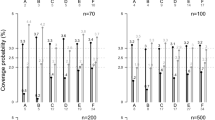Abstract
Recent studies in Lee and Prékopa (Oper Res Lett 45:19–24, 2017) and Lee (Oper Res Lett 45:1204–1220, 2017) showed that a union of partially ordered orthants in \(R^n\) can be decomposed only into the largest and the second largest chains. This allows us to calculate the probability of the union of such events in a recursive manner. If the vertices of such orthants designate p-level efficient points, i.e., the multivariate quantile or the multivariate value-at-risk (MVaR) in \(R^n\), then the number of them, say N, is typically very large, which makes it almost impossible to calculate the multivariate conditional value-at-risk (MCVaR) introduced by Prékopa (Ann Oper Res 193(1):49–69, 2012). This is because it takes \(O(2^N)\) in case of N MVaRs in \(R^n\) to find the exact value of MCVaR. In this paper, upon the basis of ideas in Lee and Prékopa (Oper Res Lett 45:19–24, 2017) and Lee (Oper Res Lett 45:1204–1220, 2017), together with proper adjustments, we study efficient methods for the calculation of the MCVaR without resorting to an approximation. In fact, the proposed methods not only have polynomial time complexity but also computes the exact value of MCVaR. We also discuss additional benefits MCVaR has to offer over its univariate counter part, the conditional value-at-risk, by providing numerical results. Numerical examples are presented with computing time in both cases of given population and sample data sets.





Similar content being viewed by others
References
Aven, T. (2016). Risk assessment and risk management: Review of recent advances on their foundation. European Journal of Operational Research, 253, 1–13.
Ben-Tal, A., & Teboulle, M. (1986). Expected utility, penalty functions, and duality in stochastic nonlinear programming. Management Science, 32(11), 1445–1466.
Boros, E., & Prékopa, A. (1989). Closed form two-sided bounds for probabilities that exactly \(r\) and at least \(r\) out of \(n\) events occur. Mathematics of Operations Research, 14, 317–342.
Dempster, M. (2002). Risk management: Value at risk and beyond. Cambridge: Cambridge University Press.
Dentcheva, D., Prékopa, A., & Ruszczyński, A. (2000). Concavity and efficient points of discrete distributions in probabilistic programming. Mathematical Programming Series A, 89, 55–77.
Föllmer, H., & Schied, A. (2002). Convex measures of risk and trading constraints. Finance and Stochastics, 6, 429–447.
Föllmer, H., & Schied, A. (2004). Stochastic Finance. Berlin: Walter de Gruyter.
Glasserman, P., & Kang, W. (2014). OR forum—Design of risk weights. Operations Research, 62, 1204–1220.
Jorion, P. (2006). Value at risk:The new benchmark for managing financial risk (3rd ed.). New York: McGraw-Hill.
Lee, J. (2017). Computing the probability of union in the \(n\)-dimensional Euclidean space for application of the multivariate quantile: \(p\)-level efficient points. Operations Research Letters, 45, 242–247.
Lee, J., & Prékopa, A. (2013). Properties and calculation of multivariate risk measures: MVaR and MCVaR. Annals of Operations Research, 211(1), 225–254.
Lee, J., & Prékopa, A. (2015). Decision-making from a risk assessment perspective for corporate mergers and acquisitions. Computational Management Science, 12(2), 243–266.
Lee, J., & Prékopa, A. (2017). On the probability of union in the n-space. Operations Research Letters, 45, 19–24.
Lee, J., Kim, J., & Prékopa, A. (2017). Extreme value estimation for a function of a random sample using binomial moment scheme and Boolean functions of events. Discrete Applied Mathematics, 219(11), 210–218.
Noyan, N., & Rudolf, G. (2013). Optimization with multivariate conditional value-at-risk constraints. Operations Research, 61, 990–1013.
Ogryczak, W., & Ruszczyński, A. (2002). Dual stochastic dominance and related mean-risk models. SIAM Journal on Optimization, 13(1), 60–78.
Pflug, G. C. (2000). Some remarks on the value-at-risk and conditional value at risk. Probabilistic constrained optimization (pp. 272–281). Boston: Springer.
Pflug, G. C., & Römisch, W. (2007). Modeling, measuring and managing risk. Hackensack: World Scientific.
Prékopa, A. (1973). Contributions to the theory of stochastic programming. Mathematical Programming, 4, 202–221.
Prékopa, A. (1990). Dual method for a one-stage stochastic programming problem with random rhs obeying a discrete probability distribution. Operations Research, 34, 441–461.
Prékopa, A. (1995). Stochastic programming. Dordrecht: Kluwer Academic Publishers.
Prékopa, A. (2012). Multivariate value at risk and related topics. Annals of Operations Research, 193(1), 49–69.
Prékopa, A., & Lee, J. (2018). Risk tomography. European Journal of Operational Research, 265(1), 149–168.
Prékopa, A., Vizvári, B., & Badics, T. (1998). Programming under probabilistic constraint with discrete random variable. Dordrecht: Kluwer.
Shapiro, A., Dentcheva, D., & Ruszczyński, A. (2009). Lectures on stochastic programming: Modeling and theory. Philadelphia: SIAM and MPS.
Szegö, Ge. (2004). Risk measures for the 21st century. New York: Wiley.
Szegö, G. (2005). Measures of risk. European Journal of Operational Research, 163(1), 5–19.
Torres, R., Lillo, R., & Laniado, H. (2015). A directional multivariate value at risk. Insurance: Mathematics and Economics, 65, 111–123.
Uryasev, S., & Rockafellar, R. (2000). Optimization of conditional value at risk. Journal of Risk, 2, 21–41.
Vizvári, B. (1987). Beiträge zum Frobenius Problem. Dr. sc. nat. Dissertation. Techniche Hochschule Carl Schorlemmer. Leuna-Merseburg, Germany.
Author information
Authors and Affiliations
Corresponding author
Additional information
Publisher's Note
Springer Nature remains neutral with regard to jurisdictional claims in published maps and institutional affiliations.
Rights and permissions
About this article
Cite this article
Lee, J., Kim, J. Partially ordered data sets and a new efficient method for calculating multivariate conditional value-at-risk. Ann Oper Res (2019). https://doi.org/10.1007/s10479-019-03366-0
Published:
DOI: https://doi.org/10.1007/s10479-019-03366-0
Keywords
- p-Level efficient points
- Partially ordered set (poset)
- Projection of distribution
- Probability of union
- Data-driven risk measures
- Binomial moments
- Orthants in the n-space
- Multivariate risk measures
- Multivariate value-at-risk (MVaR)
- Multivariate conditional value-at-risk (MCVaR)
- Value-at-risk (VaR)
- Conditional value-at-risk (CVaR)




